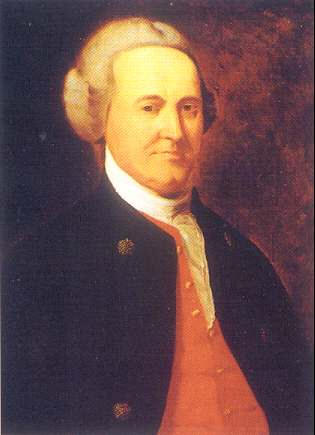 Gen. Richard Richardson
Gen. Richard Richardson
1704-1780
General Richard Richardson (my fifth great grandfather) was born in Jamestown, Virginia in 1704.
During his early adult years he was a surveyor in Virginia. In 1725, Richard moved to South Carolina, where he was married to Mary Cantey, his first wife, on Oct. 11, 1738. [1]
Few men were more important in the provincial history of South Carolina. In 1740 he was commissioned as a Captain in the SC militia. He became a Colonel of the Camden District of the South Carolina militia as early as 1757, served in the Cherokee (or Indian Border) Wars of 1760-61. He is also said to have served in the Commission of the Peace following that war.
He was in command of the militia and regulars in
the "Snow Campaign" against the Tories at Ninety Six [2] in November of 1775,
where there was a skirmish, which led to the first blood of
the Revolution in South Carolina to be shed. In retaliation, Col. Richard
Richardson raised a force of more than four thousand and in December marched
through the upper Piedmont. He defeated the loyalist militia and tracked
down the remaining Tories on the Reedy River and captured them. The Snow
Campaign (so called because of the more than fifteen inches of snow and
sleet on the ground) silenced the backcountry opposition to the Provincial
Congress.[3] Richardson also served in the Provincial Congress
during 1775-76 during which time the first Republican Constitution was
formed.
In 1776 he assisted in the defeat of the British fleet at Charleston and commanded the state militia at Purrysburg in 1778. He was appointed Brigadier General on March 25, 1778 by President (and later Governor) Rawlins Lowndes.
At the surrender of Charleston he was taken prisoner, sent to St.
Augustine and later paroled. Lord Cornwallis made fruitful efforts to
win him over to the royalist cause. Later he was imprisoned, and due to
his failing health, he was sent home where he soon died.[4]
His second wife was Dorothy Sinker.
Other highlights of his life:
- Petitioned for his first grant of land, between Halfway Swamp and Jack's Creek, later called "Big Home." (near cemetery): 1744
- Royal Assembly: 1754-60 and 1762-65
- Granted 1,000 acres in Craven County in St. Mark's Parish on the north side of the Santee River and 300 acres in Craven County in St. Mark's Parish on Santee, Futters Earth Creek (both recorded 12/16/1768)
- General Assembly: 1776 - 1780
As they moved into the interior the British troops followed orders. Executions were common, and the soldiers harassed and mistreated everyone. One commander declared that Presbyterian meeting houses were "sedition shops" and ordered them burned; another (the infamous Colonel Tarleton) upon learning of his death, burnt down his house, exhumed and abused Richard Richardson's body. [5]
He died in September 1780 while on parole as a prisoner of the British. He is buried at the Richardson Burying Ground near Rimini, South Carolina.
His tombstone reads:
Sacred to the Memory of General Richard Richardson
Who departed this life in September 1780 Aged 76 years.
He died while a prisoner And under the parole of The British who permitted
him in his illness to leave John's Island where he was confined to close the
last moments of his life in the bosom of his numerous family.
Beneath this marble his venerated remains repose which is erected to his
memory by James Burchell Richardson his eldest son by his second and last
marriage
My double connection to Gen. Richardson
My great grandmother, Ann Sinkler Richardson's parents were both Richardsons (2nd cousins): James Manning Richardson, Sr. and Mary Spann Richardson.
Tracing back for each:
- James Manning → Thomas Charles → John Peter, Sr. → General Richard Richardson
- Mary Spann → Richard Charles, Sr. → James Burchell, Sr. → General Richard Richardson
Click here for a more lengthy explanation
Other Information
- Will of General Richard Richardson (PDF format)
- Muster roll accounting:
To Pay the battalion of Colonel Richard Richardson
(as the muster roll of the said battalion was
settled by a committee of the Assembly) 14,827 11 00
To pay the men who served as butchers, horse hunters and
wood cutters for the Indians, according to a list returned
by Colonel Richardson £108 03 00
(SCMAR, Vol. IV, Fall 1976, No. 4, p.213-214)
Footnotes
- Rose Family GEDCOM, Prince Frederick Parish Register
- Ninety-Six refers to both the town and a District in the southwestern portion of the state. Click here for more details and a map showing the location.
- Walter Edgar, South Carolina a History, (Columbia, SC: Univ. of SC Press), p. 226
- There is some dispute as to
whether or not Gen. Richardson was at Charleston during the
surrender of that city to the British. Author, Edward McCrady (The
History of South Carolina in the Revolution, 1775-1780) suggests
that the general already retired due to both his age (75) and the
injuries he suffered while in captivity.
His name does not occur during the siege, nor is he mentioned among the prisoners; and Gervais, who was one of the Council with Gov. Rutledge, in a letter dated 28 April (1780), speaks of collecting the militia "from Pee Dee and Richardson's former grade-- for he resigned long ago. He had no doubt resigned because of his infirmity; he was now more than 75 years of age, and was soon to die from the effects of a imprisonment because he would not accept the terms proposed and by the conqueror. - Edgar, South Carolina a History, p. 234 and Sons of the American Revolution application form for various descendants of Gen. Richardson. See also The American Revolution in South Carolina.
